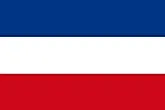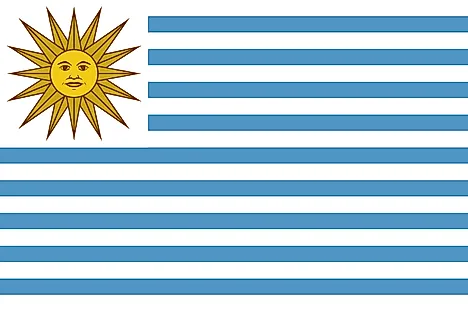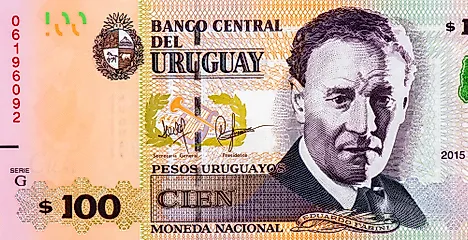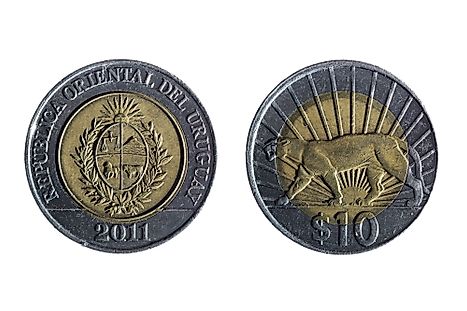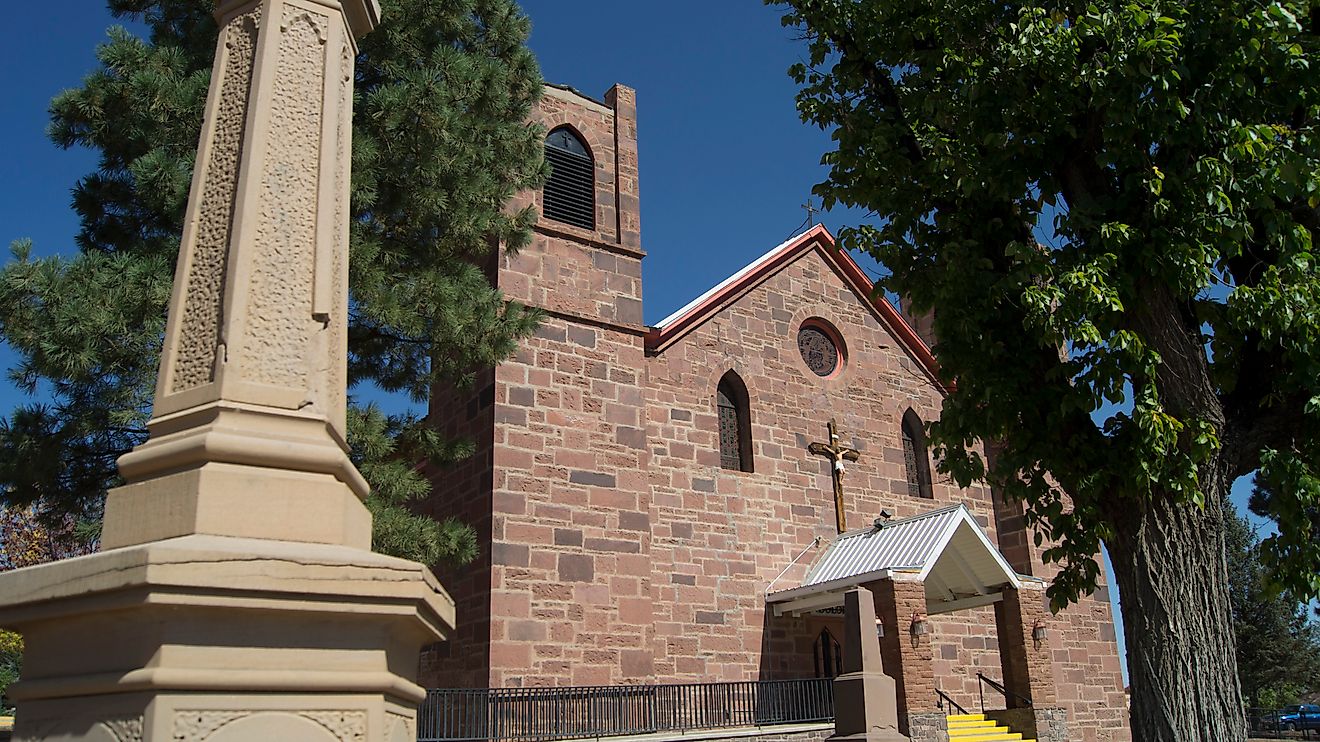Flags, Symbols & Currency of Uruguay
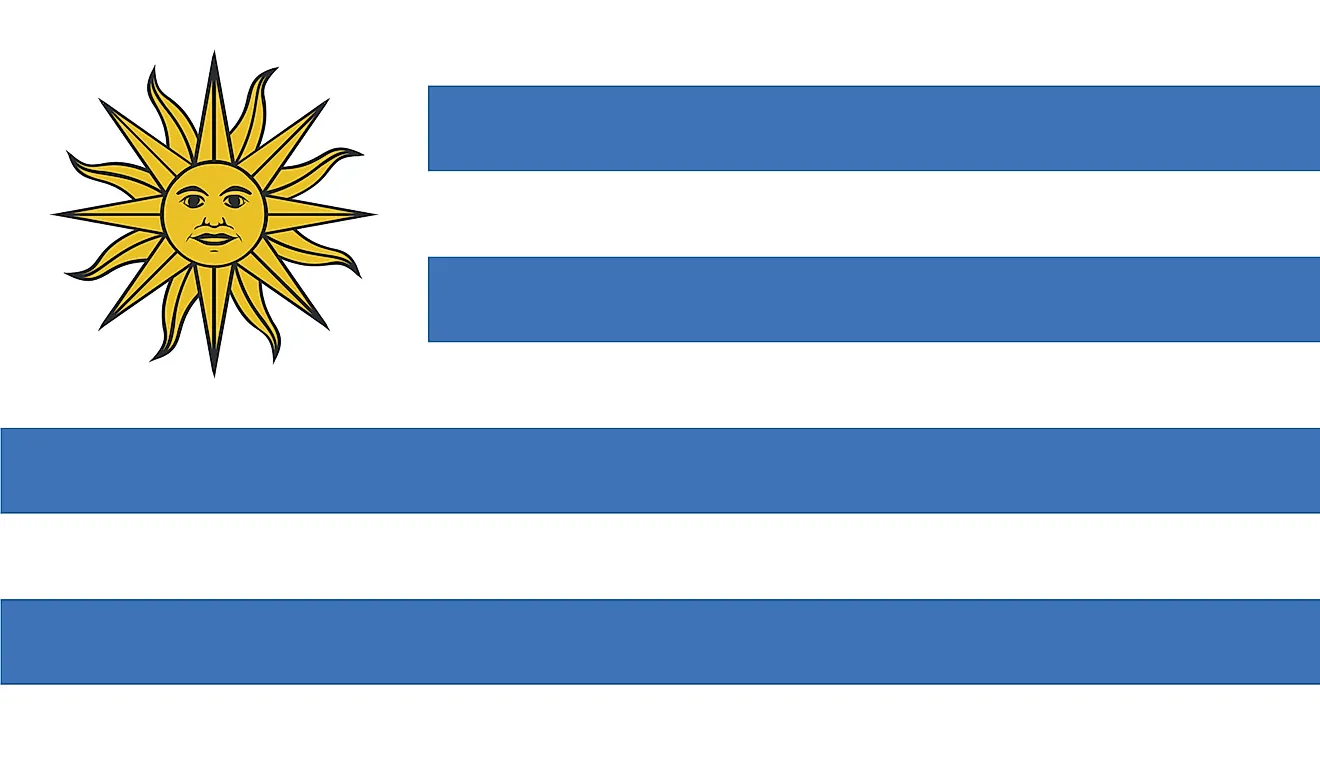
The National Flag of Uruguay was officially adopted on July 11, 1830. The flag of Uruguay was designed by Joaquín Suárez, a former Head of State who served during Uruguay's fight for independence from Spain.
The National Flag of Uruguay features nine equal horizontal stripes of white (top and bottom) alternating with blue stripes. A white square placed in the upper hoist-side corner contains a yellow sun bearing a human face. The sun (referred to as the Sun of May) is delineated with black and contains 16 rays that alternate between triangular and wavy. The nine horizontal stripes on the flag represent the nine original departments of Uruguay. The blue and white colors are modeled after the flag of Argentina. The symbol of the Sun evokes the legend of the sun breaking through the clouds on May 25, 1810, as independence was first declared from Spain. The features of the sun represent those of Inti - the Inca god of the sun. The flag has a width-to-length proportion ratio of 2:3.
There are three official flags of Uruguay. The flag described above is the main national flag. The other two being: Flag of the Treinta y Tres and the Flag of Artigas. However, all three flags are displayed on all government buildings.
History of the Flag of Uruguay
In 1812, as a part of the United Provinces of the Río de la Plata – Uruguay (Banda Oriental) flew a horizontally striped blue-white-blue flag, that was hoisted by General Manuel Belgrano. Several different flags were flown when Uruguay was under Spanish and Brazilian rule. Between 1821 and 1825, when Uruguay was known as Provincia Oriental, the Flag of Cisplatina with three horizontal stripes of green and white was flown. The Sun of May has been used as a national symbol since the 19th century. The flag flown between 1828 and 1830 was very similar to the flag flown today but, with many differences. The sun featured in the left-hand corner was slightly different. Additionally, there were 19 stripes on the flag, compared to the nine stripes featured on the modern flag. Of these 19 stripes, nine were light blue and 10 were white. The nine-light blue stripes represented the original national departments of Uruguay. The current flag of Uruguay was adopted in 1830. At this time, the shade of blue used in the flag was changed, and the number of stripes was reduced. Besides, the appearance of the sun was also changed. After 1830, the symbolism was changed so that not only blue but, all colors of the flag (white and blue) stand for the national departments.
Symbols of Uruguay
The National Coat of Arms of Uruguay

The current official National Coat of Arms /Shield of Uruguay was adopted on March 19, 1829, and has been designed by Juan Manuel Besnes Irigoyen. It consists of an oval, divided into four equal sections and crowned by a rising golden sun ("Sun of May"). The rising sun symbolizes the rising of the nation of Uruguay. On the left, the oval is surrounded by a laurel branch and on the right by an olive branch. The laurel branch represents honor and the olive branch represents peace. The two branches are tied at the bottom by an Uruguayan cockade. In the upper left quadrant of the oval on a blue field, there is a golden scale, representing justice and equality. In the upper right quadrant of the oval on a silver background, is the Cerro de Montevideo (Montevideo Hill) with its fortress on the summit; symbolizing strength. In the lower-left quadrant of the oval and placed on a silver field, is a galloping horse, representing liberty. The lower right quadrant of the oval shows a golden ox that has been placed on a blue field, represents abundance.
National Motto
"Libertad o Muerte" "Liberty or Death"
National Anthem
- Anthem Title: "Himno Nacional de Uruguay" ("National Anthem of Uruguay")
- Music Composer: Francisco José Debali
- Lyricist: Francisco Esteban Acuña de Figueroa
- Date of Adoption: July 25, 1848
"Himno Nacional de Uruguay" is the national anthem of Uruguay. The music of the anthem has been composed by Francisco José Debali. The lyrics of the anthem have been authored by Francisco Esteban Acuña de Figueroa. The original text of the lyrics had a total of 11 verses and including the musical introduction it contains a total of 105 bars which has almost a total duration of five minutes. This makes Uruguay's anthem the longest anthem in the world. Only the first verse and the chorus is generally sung nowadays.
"Himno Nacional de Uruguay" (Spanish)
Chorus:
Orientales la Patria o la Tumba!
Libertad o con gloria morir!
Orientales la Patria o la Tumba!
Libertad o con gloria morir!
Es el voto que el alma pronuncia,
Y que heroicos sabremos cumplir!
Es el voto que el alma pronuncia,
Y que heroicos sabremos cumplir!
Que sabremos cumplir!
Es el voto que el alma pronuncia,
Y que heroicos sabremos cumplir!
Que sabremos cumplir!
Sabremos cumplir!
Sabremos cumplir!
Sabremos cumplir!
First Verse:
Libertad, libertad Orientales!
Este grito a la Patria salvó.
Que a sus bravos en fieras batallas
De entusiasmo sublime inflamó.
Libertad, libertad Orientales!
Este grito a la Patria salvó.
Que a sus bravos en fieras batallas
De entusiasmo sublime inflamó.
De este don sacrosanto la gloria
Merecimos: tiranos temblad!
Tiranos temblad!
Libertad en la lid clamaremos,
Y muriendo, también libertad!Tiranos temblad!
Libertad en la lid clamaremos,
Y muriendo, también libertad!
Y muriendo, también libertad!
También libertad!
Tambén libertad!
Chorus
"National Anthem of Uruguay"
Chorus:
Eastern landsmen, our country or the grave!
Freedom, or with glory to die.
Eastern landsmen, our country or the grave!
Freedom, or with glory to die.
This is the vow that our souls take
And which we know how, courageously, to fulfil,
This is the vow that our souls take
And which we know how, courageously, to fulfil,
Know how to fulfil,
This is the vow that our souls take
And which we know how, courageously, to fulfil,
Know how to fulfil!
Know how to fulfil!
Know how to fulfil!
First Verse:
Freedom, freedom, eastern landsmen,
This cry saved our country,
Inflaming its brave men
With enthusiasm in fierce battles.
Freedom, freedom, eastern landsmen,
This cry saved our country,
Inflaming its brave men
With enthusiasm in fierce battles.
We merited the glory of this sacred gift.
Let tyrants tremble!
Let tyrants tremble!
Let tyrants tremble!
Ah, in the fight we shall clamour for freedom
And, dying still cry for it,
And, dying still cry for it,
Still cry for it,
Still cry for it.
Chorus
The Currency of Uruguay is the Uruguayan Peso
The current official currency of Uruguay is the Uruguayan Peso (UYU). The Uruguayan peso was named as the official currency in 1896. But, the current version of the currency was adopted in 1993. The Uruguayan peso is divided into 100 centesimos (cents) although there are no cents in circulations.
Coins
Currently, coins in denominations of $1, $2, $5, $10 are in circulation.
Banknotes
Currently, $20, $50, $100, $200, $500, $1000 and $2000 banknotes are in circulation.
The banknotes feature the portraits of prominent Uruguayans such as Dámaso Antonio Larrañaga and Juan Zorilla de San Martin while the country’s landmarks including the Varela Monument and the National Library are featured on the reverse. The notes are watermarked by the portrait of the country’s founding father and revolutionary leader José Gervasio Artigas.
Historical Currencies of Uruguay
The currency of Uruguay was based on the eight reales silver Peso in 1828. This currency was commonly known as Patacon (gold onza de oro) pegged at 16 silver pesos. In 1828, the provincial government permitted the circulation of foreign silver and gold coins. By 1896, Uruguay had obtained monetary stability based on gold standards. The currency remained stable until World War I began and the prices of gold became unpredictable. World War II worsened the situation as the global economy became unstable. Uruguay was hit by severe inflation in 1964 and critical in 1970. On July 1, 1975, the peso was replaced by the nuevo peso at the rate of 1000 pesos. However, the new currency failed to slow the inflation as anticipated prompting the government to issue a new version of the currency in 1993 at a rate of 1,000 old pesos to one new peso.
In 1994, Uruguay introduced the 10, 20, and 50 brass centesimos and the 1 and 2 brass pesos. The 5 and 10 pesos were introduced in 2000. The coins replaced all notes of similar value. Between 1995 and 1996, banknotes of 5, 10, 20, 50, 100, 200, 500, and 1,000 pesos were introduced but the 5 and 10 pesos were withdrawn in 2003. In the same year, the 2,000 pesos note was introduced. In 2010, the 50 centesimos coin was removed from circulation. The 20 and 50 peso coins were later withdrawn leaving the 1, 2, 5, and 10 pesos coins in circulation.
